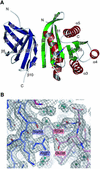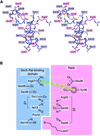Structural basis of the interaction between RalA and Sec5, a subunit of the sec6/8 complex
- PMID: 12839989
- PMCID: PMC165653
- DOI: 10.1093/emboj/cdg329
Structural basis of the interaction between RalA and Sec5, a subunit of the sec6/8 complex
Abstract
The sec6/8 complex or exocyst is an octameric protein complex that functions during cell polarization by regulating the site of exocytic vesicle docking to the plasma membrane, in concert with small GTP-binding proteins. The Sec5 subunit of the mammalian sec6/8 complex binds Ral in a GTP-dependent manner. Here we report the crystal structure of the complex between the Ral-binding domain of Sec5 and RalA bound to a non-hydrolyzable GTP analog (GppNHp) at 2.1 A resolution, providing the first structural insights into the mechanism and specificity of sec6/8 regulation. The Sec5 Ral-binding domain folds into an immunoglobulin-like beta-sandwich structure, which represents a novel fold for an effector of a GTP-binding protein. The interface between the two proteins involves a continuous antiparallel beta-sheet, similar to that found in other effector/G-protein complexes, such as Ras and Rap1A. Specific interactions unique to the RalA.Sec5 complex include Sec5 Thr11 and Arg27, and RalA Glu38, which we show are required for complex formation by isothermal titration calorimetry. Comparison of the structures of GppNHp- and GDP-bound RalA suggests a nucleotide-dependent switch mechanism for Sec5 binding.
Figures







Similar articles
-
Exo84 and Sec5 are competitive regulatory Sec6/8 effectors to the RalA GTPase.EMBO J. 2005 Jun 15;24(12):2064-74. doi: 10.1038/sj.emboj.7600699. Epub 2005 May 26. EMBO J. 2005. PMID: 15920473 Free PMC article.
-
RalA-exocyst interaction mediates GTP-dependent exocytosis.J Biol Chem. 2004 May 7;279(19):19875-81. doi: 10.1074/jbc.M400522200. Epub 2004 Feb 20. J Biol Chem. 2004. PMID: 14978027
-
Structure of the GTPase-binding domain of Sec5 and elucidation of its Ral binding site.J Biol Chem. 2003 May 9;278(19):17053-9. doi: 10.1074/jbc.M300155200. Epub 2003 Mar 6. J Biol Chem. 2003. PMID: 12624092
-
Exocytosis: the many masters of the exocyst.Curr Biol. 2002 Mar 19;12(6):R212-4. doi: 10.1016/s0960-9822(02)00753-4. Curr Biol. 2002. PMID: 11909549 Review.
-
Ral: mediator of membrane trafficking.Int J Biochem Cell Biol. 2006;38(11):1841-7. doi: 10.1016/j.biocel.2006.04.006. Epub 2006 May 9. Int J Biochem Cell Biol. 2006. PMID: 16781882 Review.
Cited by
-
Modeling the structural implications of an alternatively spliced Exoc3l2, a paralog of the tunneling nanotube-forming M-Sec.PLoS One. 2018 Aug 7;13(8):e0201557. doi: 10.1371/journal.pone.0201557. eCollection 2018. PLoS One. 2018. PMID: 30086153 Free PMC article.
-
Inducible Exoc7/Exo70 knockout reveals a critical role of the exocyst in insulin-regulated GLUT4 exocytosis.J Biol Chem. 2019 Dec 27;294(52):19988-19996. doi: 10.1074/jbc.RA119.010821. Epub 2019 Nov 18. J Biol Chem. 2019. PMID: 31740584 Free PMC article.
-
An old dog learns new tricks: novel functions of the exocyst complex in polarized epithelia in animals.F1000 Biol Rep. 2009;1:83. doi: 10.3410/B1-83. Epub 2009 Nov 16. F1000 Biol Rep. 2009. PMID: 20161436 Free PMC article.
-
Ral-Arf6 crosstalk regulates Ral dependent exocyst trafficking and anchorage independent growth signalling.Cell Signal. 2016 Sep;28(9):1225-1236. doi: 10.1016/j.cellsig.2016.05.023. Epub 2016 Jun 4. Cell Signal. 2016. PMID: 27269287 Free PMC article.
-
Septins function in exocytosis via physical interactions with the exocyst complex in fission yeast cytokinesis.bioRxiv [Preprint]. 2025 Jul 1:2024.07.09.602728. doi: 10.1101/2024.07.09.602728. bioRxiv. 2025. PMID: 39026698 Free PMC article. Preprint.
References
-
- Abrahams J.P. and Leslie,A.G.W. (1996) Methods used in the structure determination of bovine mitochondrial F1 ATPase. Acta Crystallogr. D, 52, 30–42. - PubMed
-
- Altschul S.F., Gish,W., Miller,W., Myers,E.W. and Lipman,D.J. (1990) Basic local alignment search tool. J. Mol. Biol., 215, 403–410. - PubMed
Publication types
MeSH terms
Substances
LinkOut - more resources
Full Text Sources
Molecular Biology Databases

